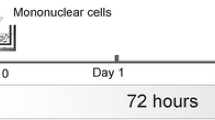Abstract
Growth factors are important regulators of cell proliferation and differentiation. They are involved in the maintenance of tissue homeostasis and repair. Fibroblast growth factors (FGFs) have multiple biological activities and can stimulate a variety of processes such as mitogenesis, differentiation, Chemotaxis, and angiogenesis [1]. FGFs are the most potent angiogenic factors discovered so far and they have potential for enhancement of wound healing and tissue repair. The “FGF family” consists of six proteins which are characterized by their heparin-binding properties.
Access this chapter
Tax calculation will be finalised at checkout
Purchases are for personal use only
Preview
Unable to display preview. Download preview PDF.
Similar content being viewed by others
References
Klagsbrun M (1989) The Fibroblast Growth Factor Family: Structural and biological properties Progress in Growth Factor Research 1:207–235
Clark RAF (1989) Wound repair Current Opinion in Cell Biology (1989) 1:1000–1008
Mustoe TA, Pierce GF, Morishima C, Deuel TF (1991) Growth Factor-induced Acceleration of Tissue Repair through Direct and Inductive Activities in a Rabbit Dermal Ulcer Model Journal of Clinical Investigation 87:694–703
Folkman J, Klagsburn M (1987) Angiogenic Factors Science (1987) 235:442–447
Trautinger F, Hammerle AF, Pöschl G, Micksche M (1991) Respiratory Burst Capability of Polymorphonuclear Neutrophils and TNF-a Serum Levels in Relationship the Development of Septic Syndrome in Critically Ill Patients Journal of Leukocyte Biology 49:449–454
Häder M, Klausmann M, Pflüger KH, Lüben G, Seiler FR, Havemann K (1989) Granulocytemacrophage colony stimulating factor binding sites and oxidative metabolism in human granulocytes Blut 59:486–492
La Rocca RV, Stein CA, Myers CE (1980) Suramin: prototype of a New Generation of Antitumor Compounds Cancer Cells 2:106–115
Wilson E, Laster SM, Gooding LR, Lambeth JD (1987) Platelet-derived growth factor stimulates phagocytosis and blocks agonist-induced activation of the neutrophil oxidative burst: A possible cellular mechanism to protect against oxygen radical damage Proc Natl Acad Sci USA 84:2213–2217
Author information
Authors and Affiliations
Editor information
Editors and Affiliations
Rights and permissions
Copyright information
© 1993 Springer-Verlag, Berlin Heidelberg
About this chapter
Cite this chapter
Macheiner, W., Oismüller, C., Pohl, W., Micksche, M. (1993). Basic Fibroblast Growth Factor Inhibits the Release of Oxygen Radicals by Human Granulocytes. In: Faist, E., Meakins, J.L., Schildberg, F.W. (eds) Host Defense Dysfunction in Trauma, Shock and Sepsis. Springer, Berlin, Heidelberg. https://doi.org/10.1007/978-3-642-77405-8_143
Download citation
DOI: https://doi.org/10.1007/978-3-642-77405-8_143
Publisher Name: Springer, Berlin, Heidelberg
Print ISBN: 978-3-642-77407-2
Online ISBN: 978-3-642-77405-8
eBook Packages: Springer Book Archive




